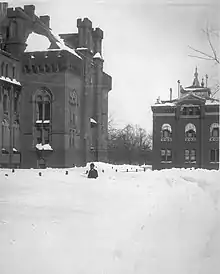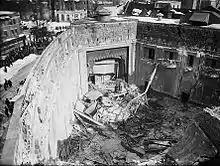Knickerbocker storm
The Knickerbocker storm was a blizzard on January 27–28, 1922 in the upper South and middle Atlantic United States. The storm took its name from the resulting collapse of the Knickerbocker Theatre in Washington, D.C. shortly after 9 p.m. on January 28 which killed 98 people and injured 133.[1]
Category 5 "Extreme" (RSI: 18.53) | |
 Weather map for the morning of January 28, 1922 | |
| Type | Extratropical cyclone Blizzard |
|---|---|
| Formed | January 27, 1922 |
| Dissipated | January 29, 1922 |
| Casualties | 98 fatalities, 133 injured |
| Areas affected | Mid-Atlantic states of the United States |
Setup for the event
An Arctic airmass was in place across the northeast United States; Washington, D.C. had been below freezing since the afternoon of January 23.[2] The front that spawned the cyclone was almost completely dry until after it crossed the Gulf of Mexico, making this storm unique among large southeast snowstorms. Despite the slow start, a low formed and deepened rapidly off the Georgia coast as the cold front reached the Gulf Stream on January 27. Heavy snow quickly developed from the Carolinas to Pennsylvania as the low drifted north to the Outer Banks of North Carolina on the 28th. A strong high pressure to the north helped to cut the system off from the jet stream. As a result, the cyclone took three days to move up the East Coast of the United States which was double the normal time used by forecasters of that era to move storm systems up the coast. Snow reached Philadelphia and Washington, D.C. by noon on January 28, and continued into the morning of January 29. Temperatures remained in the 20s Fahrenheit (-5 °C) through much of the event.[3]
Impact

An estimated 22,400 square miles (58,000 km²) of the northeast United States were affected by 20 inches (51 cm) of snow from this cyclone, which was over one-fifth of the total area that received over 4 in (10 cm) of snow. Snowfall was quite heavy in Maryland and Virginia.[4] Richmond, Virginia recorded 19 inches (48 cm). Baltimore was paralyzed as it received the most snowfall within 24 hours since 1872. Parts of North Carolina also received over one foot of snow.[5]
Impact in Washington, D.C.
The measured snow depth at the main observing site in Washington, D.C. reached 28 in (71 cm) while an observer in Rock Creek Park a few miles to the north measured 33 in (84 cm) with 3.02 in (76.7 mm) of liquid equivalent.[1] Railroad lines between Philadelphia and Washington, D.C. were covered by at least 36 in (91 cm) of snow, with drifts as high as 16 ft (4.9 m).[3] This snowstorm is the biggest in the history of Washington, D.C. since official record keeping began in 1885 (although it is dwarfed by the 36 inches (91 cm) of snow in the Washington–Jefferson Storm of January 1772).[6] Among other disruptions, Congress adjourned as a result of the storm.[5]
Theater roof collapse

The Knickerbocker Theatre was the largest and newest movie house in Washington, D.C., built in 1917 and owned by Harry M. Crandall.[7] The roof was flat, which allowed the snow to collect on it. During the movie's (Get-Rich-Quick Wallingford) intermission, the heavy, wet snow split the roof down the middle, bringing down the balcony as well as a portion of the brick wall. Dozens were buried. The disaster ranks as one of the worst in Washington, D.C. history.[1] Congressman Andrew Jackson Barchfeld was among those killed in the theater. The theater's architect, Reginald Wyckliffe Geare, and owner, Harry M. Crandall, later killed themselves.[8]
References
- Ambrose, Kevin. "The Knickerbocker Snowstorm of January 27–28, 1922". Washington Weather Book. Retrieved 2006-10-24.
- "The Greatest Storms of the Century in the Greater Washington-Baltimore Region". National Weather Service Office Sterling, Virginia. Retrieved 2006-10-24.
- "Quotes: Page 6". Archived from the original on 2009-08-07. Retrieved 2006-10-24.
- "History of Significant Snowstorms in the Northeast U.S." New Hampshire Homeland Security and Emergency Management Operations. Retrieved 2006-10-24.
- Kocin, Paul; Uccellini, Louis (2013-03-28). Northeast Snowstorms. 1. Springer Science & Business Media. pp. 325–328. ISBN 9781878220325.
- Keith C. Heidorn (January 1, 2012). "The Washington and Jefferson Snowstorm of 1772". The Weather Doctor. Retrieved January 25, 2016.
- Gomery, Douglas (Spring–Summer 1997). "A Movie-Going Capital". Washington History. The Historical Society of Washington, D.C. 9 (1): 4–23.
- Fishbein, Gershon (January 22, 2009). "A Winter's Tale of Tragedy". The Washington Post. Retrieved 2009-01-24.
Further reading
- Siddons, Justice (December 6, 1927). "Knickerbocker Disaster Worst in 50 Years". Washington Post.
- Ambrose, Kevin (2013-01-01). The Knickerbocker Snowstorm (Images of America). Arcadia Publishing.
- Ambrose, Kevin (January 27, 2017). "Haunting faces, scenes and stories from the Knickerbocker Theatre roof crash 95 years ago". Washington Post.
External links
| Wikimedia Commons has media related to Knickerbocker blizzard of 1922. |